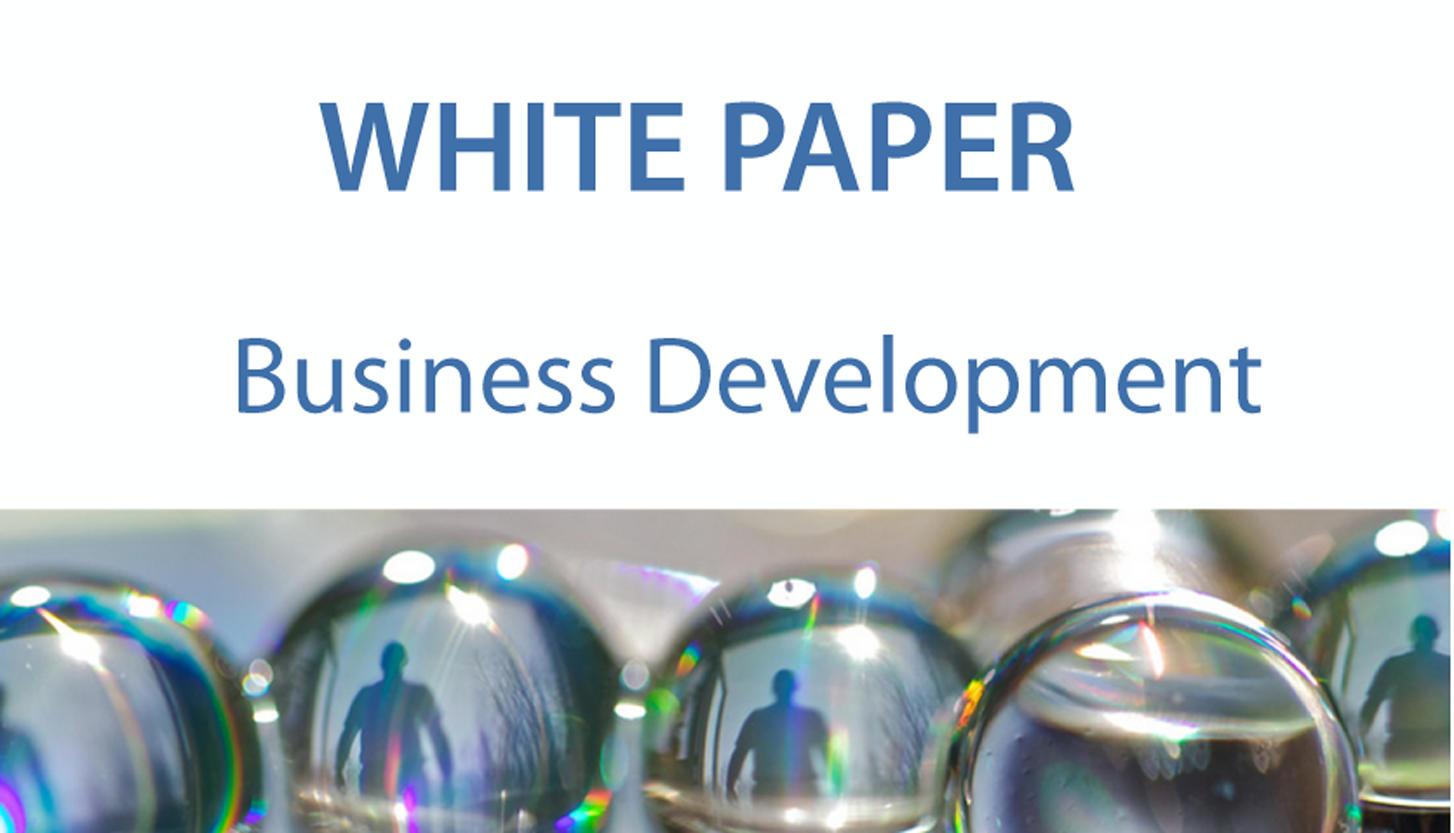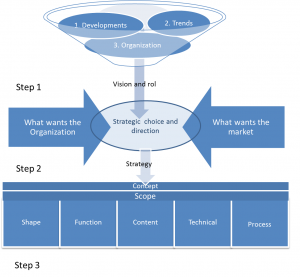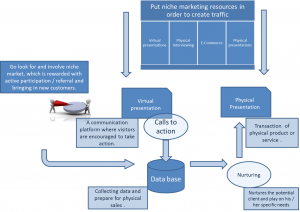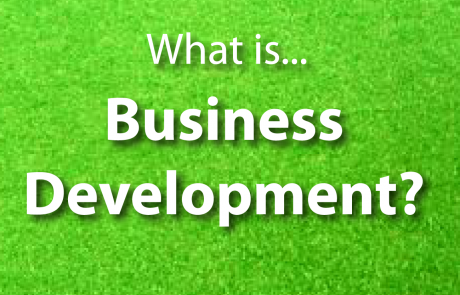Project Description
Business development and conversion from strategy to tactics:
Introduction
In this paper I will explain how business development and the associated conversion of strategy into tactics can be successfully done, according to my experience. I am going to show you how my φ-method brings remarkable results when an organization wants to grow, both nationally and internationally.
My vision often raises questions and confusion and I am fully aware of that. It is up to you whether you let these be your guide, or examine the accumulated experience and its corresponding results. If any questions come to mind while reading this white paper, statements need clarification, or you wish further information on the φ-method and how a process of growth can be established, please feel free to contact me.
I’ll start with my definition of ‘Business Development’. Then I will outline a brief history that has led to the development of the φ-method, followed by an explanation of this approach. Subsequently, I discuss an example case in which I have applied the φ-method and show you the corresponding results. The figures that are depicted in this paper originate from the lectures I give as a visiting professor at the University of Twente (i.a.). Apart from English, this paper also appears in Dutch and German, as I mainly operate in the Benelux and the entire German-speaking region.
Business Development
Business development pursuits national and international growth of organizations. The discipline can cover many different aspects of business, such as marketing, product and service development, leadership development, improvement of efficiency, quality, flexibility, etc.
As business development includes a variety of organizational aspects, it is crucial that the business developer is a “generalist”. Pragmatic and project-oriented are two other important features of the business developer. Finally, it is a person who understands the translation of strategy into tactics and day to day activities, who is able to implement these, and bears responsibility for the achievement of the goals set.
History
In the second half of the 20th century an overall interest emerged in structural development and engineering of business structures. This interest was fuelled by the emergence of scientific management, which enabled companies to optimise their business processes as logically and mechanically as possible, resulting in huge leaps in productivity.
For example, the Hawthorne experiments showed that mere attention to employees leads to higher productivity, the so-called Hawthorne effect. These experiments laid the foundation for the current Human Resource Management.
In the ‘50s of the last century, Toyota decided to actively involve its employees in the optimization of the internal processes of their day-to-day activities, therefore increasing efficiency and productivity. Under the motto ‘waste is everywhere”, the employees were trained to think and act in a continuous process of improvement and waste elimination. In addition, the work was no longer divided into small operations, which each individual performed only in part, but the entire process, from beginning to end, was executed by the same employee(s). Therefore, sub-optimization was eliminated. Ever since, the amount of business models has increased, such as business process re-engineering, lean manufacturing, core quality. Also marketing models have been developed, like the Balance Score Card and the Blue Ocean Strategy.
In the early ‘90s of the last century, I was asked to merge 2 divisions, with minimal loss of employees. I was looking for models that could help me and found clues in the Hawthorne experiments and the experiences at Toyota. Based on this, I have developed the φ-method (phi method). The core principle of this method is that everything should be in balance, employees should feel comfortable in their work environment, and they do what they do best.
The φ-method
The φ-method is based on three organizational units: Commerce, Operational and Finance. Each unit contains a certain capacity (i.e. effort, time, people and resources), which is adjusted depending on the (desired) situation; sometimes focussing on commercial activities, sometimes on operational ones etc. Meaning that the effort is not necessarily equally divided over Commerce, Operations and Finance. However, there should always be a certain balance between the three units.
Furthermore, the employees who are normally merely active in financial and operational areas are granted influence on commercial activities and vice versa. The Toyota-model taught me that not every person is able to perform equally in all three fields of expertise and excels in only one of the organizational units. This implies that everybody can work as an generalist but one specialism always directs ones actions.
Summarised and translated to an organization, this means that the effort per organizational unit, balanced over the several areas, determines the success of the growth scenarios and ambitions.
The φ-method translated to strategy in practise provides a symbioses between strategy and organization as well as market and organization and vice versa. The organizational structure is designed in such a way that Commerce, Operations and Finance are attuned in order to achieve an optimum on efficiency and effort.
Conversion from Strategy to Tactics
In practice, translating strategy into tactical deployment appears to be a tricky part. My process herein is as follows:
I analyze the existing vision, combined with the ‘desired’ strategy or strategy developed. The strategy of the organization states what the organization strives to achieve in the different target groups (figure 1). Usually, this vision is too vague and unspecific to work with. By drafting a concrete and realistic concept I establish a clear scope. Such a concept is needed to close the gap between the strategic principles and the tangible results that the organization wants to achieve (figure 2).
Case
A German-Italian producer of semi-finished products has been unsuccessful to establish growth for several years in a row. Profitability has been decreasing accordingly and investors seek possibilities to create profit growth and opportunities for growth in both the national and international arena.
- Strategic starting point. Increase customer portfolio in order to improve cash flow.
- Impact on organization. It was critical to create public support from employees for the foreseen plans, let the employees participate in the plans, and create transparency on the outcomes of the improvements for them personally.
- Available budget and capacity. In order to establish a fluent growth scenario, a balance between acceptance and execution of plans is crucial in order to prevent work pressure.
- Dependencies. Without modernization of production resources, communication tools and infrastructure the company would seize to be able to survive without current economical environment.
Regardless the scope of the project, it is crucial to have a clear and widely spread understanding of the foreseen development strategy. When set goals and expectations are clear for all parties involved, joint focus can be placed upon the solutions and the applicable activities required to achieve these goals. Following this definition, I went to work with the subsequent questions:
- How should the solutions and activities look like?
- Is it a change in the current situation / activity, or it is a change to expand current activities?
- What features should these changes contain?
- What should be the content?
- What techniques are available and usable?
- Where and who can we deploy for support (customers, suppliers or networks)?
- How will I train and coach the employees?
After drawing up a plan of action, the aforementioned questions become clear. This plan gives direction to what needs to be done in a structured way to translate strategy into tactics. The main features of this plan are:
- Background and purpose
- Strategic starting points
- Preconditions
- Activities by focus areas / focal point(s)
For example, a road book arises in which all actions are described, and when the action takes place (Figure 3).
After the creation of a plan of action the project organization is organized.
By training people in the φ-method, the following results have been realized in 4 years time:
- A new efficient production plant on existing location
- A production facility in the Ukraine
- A new improved identity
- 3 new distribution channels
- E-commerce sales methods combined with physical sale
- Sales activities in 5 different countries
- Increase of employment from 225 fte to 296 fte
- Revenue growth of 32% and a profitability growth of 16 points
These growth figures where realized due to:
- Adapting and sharing resources depending on workload between Commerce, Operations and Finance
- Enforcing transparency on all relevant data regarding requirements and customer demands throughout all fields of expertise
- Creating a work ethic in which all employees take responsibility to execute all necessary tasks in order to achieve customer satisfaction
- Focus all effort of the organization on growth and prevent loss of resource utilization on priority focus
- Establishing corporate focus on translating customer demand and market patterns into actions to adapt to changing requirements
Peroration
I am fully aware that my vision is received with scepticism and is ridiculed regularly. I gladly invite those individuals to exchange ideas and discuss their visions based upon realized measurable results and past experience
Like Bruce Lee once said; “Simplicity is the key to Brilliance”
During the last couple of years we have experienced harsh times in the market and time has come to change our approach in doing business. An economic environment based on co-operation and working with one another towards a healthier society, in order to restore the balance.
With all due respect to science, I dare to say that true strength lies in experience, capabilities and ability to recognize answers on crucial topics in simplicity without being blind to obvious solutions
About the author
I have been an entrepreneur for 22 years. After being the owner and strategic project manager for six years of a project company (SPM-Group en R-Project ) I have used my experiences with exponential growth for setting up a Strategic Project advice Groupe (I&BD en the SϕM). This group helps organizations to increase international growth i after years of static results. As the chairman of the board of I&BD and CEO of SϕM for a period of twelve years we have seen continuous growth. Subsequently, I started to be the supervising advisor of Longhouses in Vaduz. Ever since, we have established 5 Longhouses subsidiaries in 5 different countries.
Companies in a wide variation of economical scale in Europe and Asia (like BTR – Auping – Dumo Chemicals – van Landschoot Textiles – National Westminster Bank – Lundiform – BCG) have benefitted from my advice and under my supervising developed strategies; always focussed on growth, stability and acceleration of profitability of its end consumer.
After more than two decades of international operations, I returned to my base in Germany and decided to focus on ambitious and innovative SMEs in the German-speaking countries and Benelux where my knowledge and experience can add value. My goal is to assist in their strategic developments, accelerate the outcome of these developments and tactically execute the strategically set targets. My heart lies at entrepreneurship, both to initiate start-ups and enabling existing entrepreneurs accelerating their growth scenarios nationally as well as internationally.
As a shareholder in I&BD and SφM I make this possible. I also fulfill a position as a guest lecturer at several universities. Besides this I am also active in advisory positions and directorships.
In case you would like to learn more about this paper, about me, or the provided cases, please do not hesitate to contact me; I will be more than willing to meet you in person and discuss our potential mutual interests.
Jos Slijkhuis










